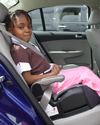Top Booster Seat and Seat Belt Safety Tips
- Use a car seat with a harness or booster seat with the vehicle lap AND shoulder safety belts until your child passes the Safety Belt Fit Test.
- Vehicle seat belts are designed to fit an average-sized adult. To get the best protection from a seat belt, children usually need a booster until they are about 4 feet 9 inches tall and weigh between 80 and 100 pounds. Many children will be between 8 and 12 years of age before they meet these height and weight requirements.
- Use a booster seat correctly in a back seat every time your child rides in a car.
- Older kids get weighed and measured less often than babies, so check your child’s growth a few times a year.
- Be sure to correctly install your car seat or booster seat. Booster seats are not installed the same way car seats are. Booster seats sit on the vehicle seat and are used to properly position the adult seat belt for an older child.
- A booster seat uses no harness. It uses the vehicle’s lap AND shoulder belts only. Be sure the seat belt is properly buckled.
- For children who are riding in booster seats, never place the shoulder belt under the child's arm or behind the child's back.
- Be sure all occupants wear safety belts correctly every time. Children learn from adult role models.
- Tell all drivers who transport your child that a car seat or booster seat use is a must when your child is in their vehicles.
- Treat seat belts as you would any cord or rope. Do not allow children to play with them at any time.
- When your child reaches 4 feet 9 inches and between 80 to 100 pounds, use the Safety Belt Fit Test to determine if the child is big enough to use the adult seat belt without a booster. Use the Safety Belt Fit Test on every child under 13.
The Safety Belt Fit Test
Have your child sit in a back seat with his or her bottom and back against the vehicle’s seat back. Do the child’s knees bend at the seat’s edge?
- If yes, go on.
- If not, the child must stay in a booster seat.
Buckle the seat belt. Does the lap belt stay low on the hips or high on the thigh?
- If yes, go on.
- If it rests on the soft part of the stomach, the child must stay in a booster seat.
Look at the shoulder belt. Does it lie on the collarbone and shoulder?
- If yes, go on.
- If it is on the face or neck, the child must remain in a booster seat.
Never put the shoulder belt under the child’s arm or behind the child’s back. Do not allow children to play with the shoulder portion of a seat belt. Treat it like any cord.
Can the child maintain the correct seating position with the shoulder belt on the shoulder and the lap belt low across the hips, or high on the thighs?
- If yes, the child has passed the Safety Belt Fit Test.
- If no, the child should return to a booster seat and re-test in a month
Magda Rodríguez
Safe Kids of Western Massachusetts
Baystate Children's Hospital
50 Maple Street
Springfield, MA 01103
413-794-6510
Fax: 413-794-6510
magda.rodriguez@baystatehealth.org
http://safekidswmass.blogspot.com/







